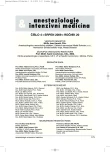Measurement of trans-alveolar pressure with a pulmonary artery catheter
Authors:
Zvoníček Václav; Suk Pavel; Šrámek Vladimír; Pavlík Martin
Authors‘ workplace:
Anesteziologicko-resuscitační klinika, Fakultní nemocnice u sv. Anny v Brně, Lékařská fakulta Masarykovy univerzity
Published in:
Anest. intenziv. Med., 20, 2009, č. 4, s. 192-199
Category:
Intensive Care Medicine - Original Paper
Overview
Objective:
Trans-alveolar pressure (Pt) is the difference between alveolar pressure and pleural pressure. To calculate Pt it is necessary to measure pleural pressure using an oesophageal balloon which is not commonly available. The aim of the study was to estimate respiratory pleural pressure changes and thereby the trans-alveolar pressure changes using the respiratory swing of central venous pressure, pulmonary artery pressure and pulmonary artery occlusion pressure. The method is based on transmission of pleural pressure changes during the respiratory cycle to the vascular pressures. The hypothesis was that pleural pressure changes during the respiratory cycle were near-equal to the vascular pressure changes.
Setting:
ICU, University Hospital.
Design:
A prospective comparison of two methods of measurement.
Material and methods:
In 23 mechanically ventilated patients we applied different tidal volumes and simultaneously measured the changes of oesophageal pressure (PtES) and vascular pressures using a pulmonary artery catheter. We calculated the changes of trans-alveolar pressure during the respiratory cycle using a standard method – oesophageal pressure – and compared them to the changes of trans-alveolar pressure calculated from CVP (PtCVP), PAP (PtPAP) and PAOP (PtPAOP).
Results:
The bias and limits of agreement according to Bland-Altman were: PtCVP -1.3 (-4.1–1.5), PtPAP 1.6 (-2.3–5.4) and PtPAOP 0.9 (-3.6–5.5) cmH2O. The best results were achieved when estimation of PtES was performed using a pulmonary artery catheter with the tip of the catheter correctly positioned in West Zone III. Eighty percent of the measurements had good clinical agreement under this condition.
Conclusion:
The respiratory swing of trans-alveolar pressure can be acceptably estimated using the pulmonary artery occlusion pressure trace provided that the pulmonary artery catheter is optimally positioned.
Keywords:
pleural pressure – central venous pressure – pulmonary artery wedge pressure – mechanical ventilation
Sources
1. Terragni, P. P., Rosboch, G., Tealdi, A., Corno, E., Menaldo, E., Davini, O., Gandini, G., Herrmann, P., Mascia, L., Quintel, M., Slutsky, A. S., Gattinoni, L., Ranieri, V. M. Tidal hyperinflation during low tidal volume ventilation in acute respiratory distress syndrome. Am. J. Respir. Crit. Care Med., 2007, 175, 2, p. 160–166.
2. Ventilation with lower tidal volumes as compared with traditional tidal volumes for acute lung injury and the acute respiratory distress syndrome. The Acute Respiratory Distress Syndrome Network. N. Engl. J. Med., 2000, 342, 18, p. 1301–1308.
3. Gattinoni, L., Carlesso, E., Cadringher, P., Valenza, F., Vagginelli, F., Chiumello, D. Physical and biological triggers of ventilator-induced lung injury and its prevention. Eur. Respir. J. Suppl., 2004, 47, p. 15s–25s.
4. Chiumello, D., Carlesso, E., Cadringher, P., Caironi, P., Valenza, F., Polli, F., Tallarini, F., Cozzi, P., Cressoni, M., Colombo, A., Marini, J. J., Gattinoni, L. Lung stress and strain during mechanical ventilation for acute respiratory distress syndrome. Am. J. Respir. Crit. Care Med., 2008, 178, 4, p. 346–355.
5. Zin, W.A., Milic-Emili, J. Esophageal pressure measurement In: Tobin, M. J. Principles and Practice of Intensive Care Monitoring, McGraw-Hill: 1997, pp 545–552 . ISBN 0070650942.
6. Pinsky, M. R. Hemodynamic Effects ov Ventilation and Ventilatory Maneuvers. In: Scharf, S. M., Pinsky, M. R., Magder, S. Respiratory-Circulatory Interactions in Health and Disease. Marcel Dekker, Inc.: New York 2001. Chapter 8, pp. 183–218. ISBN 0824704746.
7. Kallet, R. H., Katz, J. A., Pittet, J. F., Ghermey, J., Siobal, M., Alonso, J. A., Marks, J. D. Measuring intra-esophageal pressure to assess transmural pulmonary arterial occlusion pressure in patients with acute lung injury: a case series and review. Respir. Care, 2001, 45, 9, p. 1072–1084.
8. Baydur, A., Behrakis, P. K., Zin, W. A. et al. A simple method for assessing the validity of the esophageal balloon technique. Am. Rev. Respir. Dis., 1982, 126, p. 788–791.
9. Teboul, J. L., Besbes, M., Andrivet, P., Axler, O., Douguet, D., Zelter, M., Lemaire, F., Brun-Buisson, C. A bedside index assessing the reliability of pulmonary artery occlusion pressure measurements during mechanical ventilation with positive end-expiratory pressure. Journal of Critical Care, 1992, 7, 1, p. 22–29.
10. Bland, J. M., Altman, D. G. Measuring agreement in method comparison studies. Stat. Methods Med. Res., 1999, 8, 2, p. 135–160.
11. Bland, J. M. The Half-Normal distribution method for measurement error: two case studies. 2005. Dostupné na www: www-users.york.ac.uk/~mb55/talks/halfnor.pdf
12. Benjamini, Y., Hochberg, Y. Controlling the false discovery rate: a practical and powerful approach to multiple testing. J. Roy. Statist. Soc., 1995, 57, 1, p. 289.
13. Washko, G. R., O’Donnell, C. R., Loring, S. H. Volume-related and volume-independent effects of posture on esophageal and transpulmonary pressures in healthy subjects. J. Appl. Physiol., 2006, 100, 3, p. 753–758.
14. Marini, J. J., O’Quin, R., Culver, B. H., Butler, J. Estimation of transmural cardiac pressures during ventilation with PEEP. J. Appl. Physiol., 1982, 53, 2, p. 384–391.
15. Brower, R., Wise, R. A., Hassapoyannes, C., Bromberger-Barnea, B., Permutt, S. Effect of lung inflation on lung blood volume and pulmonary venous flow. J. Appl. Physiol., 1985, 58, 3, p.954–963.
16. Bellemare, P., Goldberg, P., Magder, S. A. Variations in pulmonary artery occlusion pressure to estimate changes in pleural pressure. Intensive Care Med., 2007, 33, 11, p. 2004–2008.
17. Walling, P. T., Savege, T. M. A comparison of oesophageal and central venous pressures in the measurement of transpulmonary pressure change. Br. J. Anaesth., 1976, 48, 5, p. 475–479.
Labels
Anaesthesiology, Resuscitation and Inten Intensive Care MedicineArticle was published in
Anaesthesiology and Intensive Care Medicine

2009 Issue 4
Most read in this issue
- The utilization of fiberoptic bronchoscopy in intensive care
- A patient with severe and protracted hypoglycaemia
- Early identification of critically ill patients with the MEDICAL EMERGENCY SYSTEM in St. Ann University Hospital, Brno
- Measurement of trans-alveolar pressure with a pulmonary artery catheter
